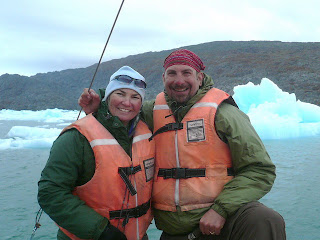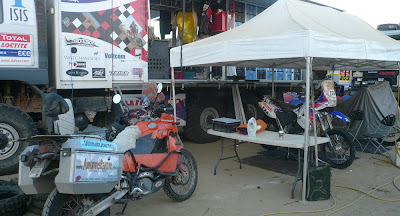Carretera Austral – 1,247kms through Chile’s remote fjords, lakes, and glaciers.

The end of the road… what a great destination! We’re in Villa O’Higgins, in the southern end of mainland Chile. The Carretera Austral stretches through this area of fjords and glaciers, and after more than 700 miles of sand, gravel, rocks, potholes, corrugation, a ferry, and some of the most stunning views, it comes to an end here.
Dec 11, 2008 - We entered Chile again near Futaleufú, a small town known around the world for its class 5+ rapids. Kayakers and rafters from all corners of the globe come to test their skills against the mighty Futaleufú. Unfortunately, a recent eruption of the volcano near Chaiten has blanketed the town in a thick layer of fine ash. The air has been tough to breath for several months, but these hardy folks are staying put, and the short tourist season is about to begin. As we rode along the bank of the Rio Futaleufú, the crushing sound of the waves reverberated off the canyon walls and up to the road.
We stopped at a small bridge where rafters unload, and ran into Josh, one of the tour operators. He looked at the bike and said, “UltimateJourney.com, I remember you guys when you rafted here years ago”. The really bizarre thing is that he remembered our names (he’s an American), and we rafted with a different company nearly 7 years before. He said he had followed our journeys for years. Small world!
We arrived at the campground in the Parque Nacional Queulat a few hours before sunset, setup our tent, and after a simple dinner we had a pretty good sleep under a crystal clear sky loaded with stars. We had purchased a cheapo tent and air mattresses the week before in Bariloche, and the only problem was Erin’s pillow section lost air during the night. With no wind or rain and perfect temperature the equipment was OK. In the morning we took a walk to see the “hanging glacier” and the roaring rapids below it. Some 50 years ago the glacier’s edge was at the campground, but over the years it’s pulled back quite a long way and now hangs off a cliff spilling forth a spectacular waterfall.

Further south we stopped in Coyhaique for a couple of nights, the main city of the region. We remembered it as being a quaint place focused on adventure tourism. It has grown into a commercial city, the population bursting past the city’s edges. We stopped in to see our friends Santi and Chus, who own a popular hostel. While their hostel hasn’t changed much they are now separated and have different partners, but are still running the business together. It’s highly rated in all the guide books, has a steady stream of clients, and is up for sale if you are interested.
Lunch stop with another RTW traveler - a converted city bus with a great view of Cerro Castillo:

Dec 14 we arrived at the small village of Puerto Rio Tranquillo. There are 3 streets that run north-south; 4 more that run east-west, and it sits on the western edge of Lago General Carrera (Chile)/Lago Buenos Aires (Argentina). While it looks nothing like you might imagine from the name, it was an extremely relaxing place and we stayed several days in a great little cabana.
The first night we took a small launch (boat) out to an island to see the Marble Caves. This name makes sense as the caves look like chiseled marble, and the small launch maneuvered in and out of the many openings. The ride back had its own adventures with some strong winds and big waves, but the young captain managed the small vessel exceptionally well.
The next day we took yet another scenic ride out to a glacier field situated down a narrow, twisting valley with hanging glaciers at every turn and hundreds of waterfalls. Ice balls filled the river downstream, formed by the rapids. After a 20 minute hike through lush rain forest we came to the purpose-built viewpoint and took in its sheer size. Much like viewing the Grand Canyon, its hard to believe what you are seeing with your own eyes is really real.

Dec 17 we arrived in Coletta Tortel, a small village that first started seeing tourists a few years ago when a road was constructed to reach its inhabitants. Set on the edge of the fjords, there are no streets and all passageways are made using stairs and boardwalks at various levels, and it takes about 15 minutes to walk from one end to the other. Built into the side of small mountains, the walkways zig-zag in countless directions. Supposedly, if you stretch out the stairs/walkways, they would be some 15 miles long.
This was the other way around town. The boat we took to the glaciers was only slightly larger
Dec 18 we signed on with 5 other travelers to visit the Montt Glacier in the Southern Ice Field. The trip was 4.5 hours one way (11 hours total), and it was a boat without many comforts. That being said, we had a lot of fun, saw some amazing sites, and have some great memories. When we finally got to the glacier field, it was well worth it! The lagoon leading up to the glacier is filled with whimsically shaped ice bergs of all different sizes. The captain pulled along side one of the largest icebergs and one of the young travelers on the journey jumped on the ice. Unfortunately for him, one of the anchors slipped and the boat drifted away. He had to stand there, perfectly still so as not to slip and fall into the frigid water, until several minutes later when we were able to pull close again and re-anchor. One of the other young travelers brought a large bottle of whiskey aboard, and we retrieved a small iceberg to chill it and serve it over ancient ice cubes. Not a drop was left in the bottle, and the ride back was spent in the warmth of the crowded cabin below deck sharing travel stories and nibbling on Christmas fruit cake.
Life inside the boat:
Back in town, the owner of our hospedaje shared a bit of his story. He was born in 1962 in a tent into a family of 13 children in what was then a small logging camp in Caleta Tortel. The local industry was until recently wood, cutting down by hand and dragging to the shore to be shipped further south to the large port of Puerto Arenas. Houses and shops appeared about 25 years ago, and they had no power and no running water until only a few years ago. Even today local kids still have to go to high school/boarding school 300 miles away in Coyhaique.
Dec 20 – We arrived in Villa O’Higgins yesterday, to an awesome little guest house at the very end of the Carratera Austral, the southern-most town in mainland Chile, and it feels like the bottom of the world! Glaciers, icebergs, fjords, clouds, rain, sunshine, lakes, mountains, rivers, warm, cold, etc... If you don't like the weather, just wait a few minutes.
The new road, along with a newly opened pedestrian passage to Argentina will see this sleepy little village transform in the coming years. In the past, travelers had to back-track from here, up to the north a couple of days journey, cross into Argentina, then take the famous Ruta 40 down to Tierra del Fuego. Now, with a passenger boat from Villa O’Higgins across the lake, the journey includes a ferry ride to a hiking trail (or horse ride) to another ferry to a small bus into El Chalten, Argentina and the famous Mount Fitzroy, high on any international trekker’s “to do” list. Unfortunately the boats won’t take the motorcycle (or any cars for that matter) across on the passenger ferry nor are we allowed to ride the small trail.

Some of you may be wondering how one gets gas in these remote areas – it is simple, they take gas from large barrels (imagine 55 gallon drums) and pour into 2 liter coke bottles. To fill our bike, it’s 22 liters (5.8 gallons), so they refill the bottles a whole bunch of times!
So, tomorrow we will mark the longest day of the year in the southern hemisphere by turning the bike around and heading north.
Safety first?


